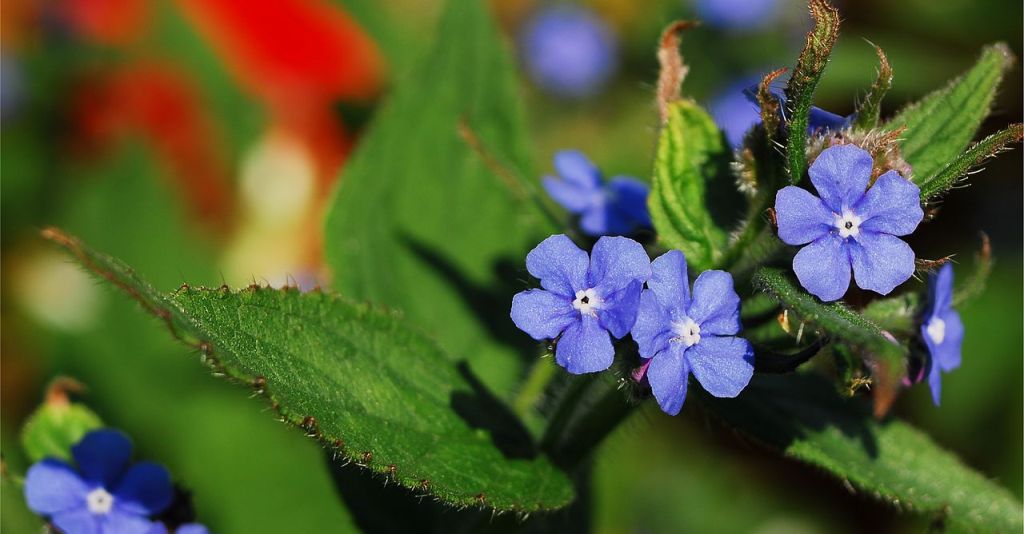
This week I would like to talk about most of our native genera of the Boraginaceae or Borage Family. This is family number 114 in Stace.
My customers sometimes complain about 2 members of the Borage family: the Green Alkanet; scientifically known as Pentaglottis.
To a less extend they complain about the abundance of seedlings of Forget-me-nots in their gardens, but I think that is just showing off! As who can be upset when you see all that magnificent blue; they are all wonderful weeds really!
All there uses and benefits will be explained in this as well as in the next post, which is entirely about the Comfrey.
Pictures by Matt Summers, unless stated.
Blue background is for general interest, Pink as a warning or medicinal use and green background for all other known uses such as food and wildlife. Please use the jump links in the contents below also for quick access. Ecology information from PlantAtlas 2020 Online, Wikipedia
Contents
General Anatomy of the Boraginaceae
Pentaglottis sempervirens or Green Alkanet
Myosotis or the Forget-me nots
Cynoglossum officinale or Houndstongue
Echium vulgare or Viper’s-bugloss
Mertensia maritima or Oysterplant
Lithospermum spp. or Gromwell
- Lithospermum officinale or Common Gromwell
- Aegonychon purpureocaeruleum or Purple/ Field Gromwell
Pulmonaria spp. or Lungworts
- Pulmonaria obscura or Suffolk Lungwort
- Pulmonaria officinalis or Lungwort
General Anatomy of the Boraginaceae:
The genera of this family have inflorescences that have a coiling shape, at least when new. The corolla varies in shape from rotate to bell-shaped to tubular, but it generally has five petals. It can be green, white, yellow, orange, pink, purple, or blue.
Most of the pollination is by hymenopterans, such as bees.
They mostly have hairy leaves. The coarse character of the hairs is due to cystoliths of silicon dioxide and calcium carbonate. These hairs can induce an adverse skin reaction, including itching and rash in some individuals, particularly among people who handle the plants regularly, such as gardeners.
In some species, anthocyanins cause the flowers to change color from red to blue with age. This may be a signal to pollinators that a flower is old and depleted of pollen and nectar.
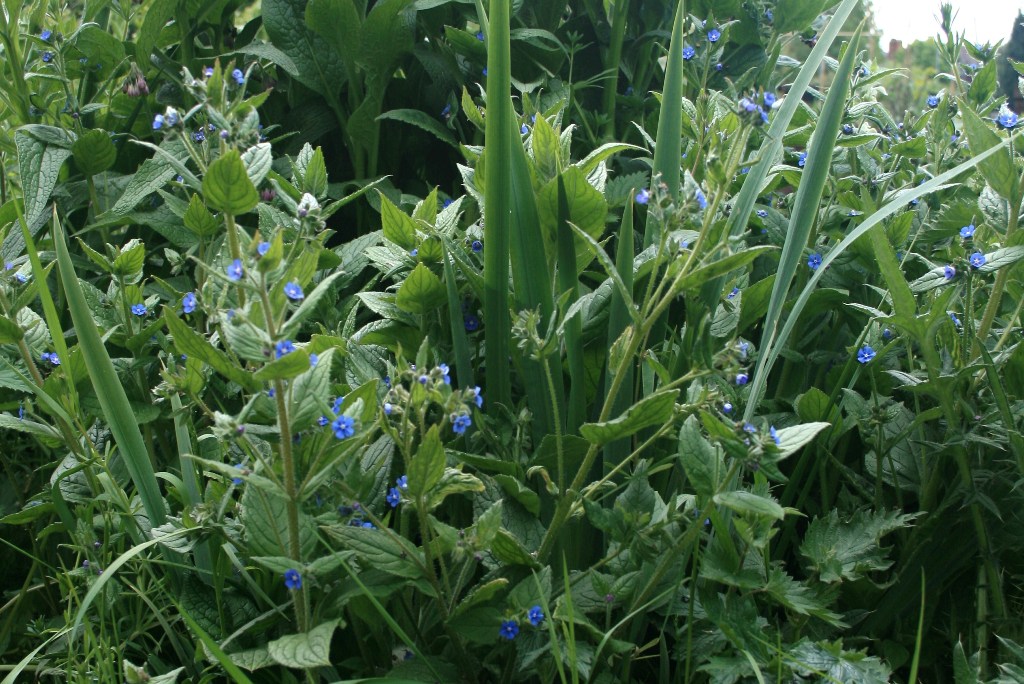
Pentaglottis sempervirens or Green Alkanet
I am starting off with Pentaglottis sempervirens or Green Alkanet which is a neophyte according to the ‘Online Atlas of the British and Irish Flora’ and flowers during several months from spring into summer with bright blue flowers on long stems.
An erect perennial herb, found naturalized close to human habitations in lightly shaded habitats, including waste ground, pavements, tracksides, roadsides, hedgerows, scrub, woodland and by rivers and streams. It reproduces prolifically from seed, has a deep tap root, and can be very invasive in woodlands
It was introduced to British gardens before 1700 and was known from the wild by 1724. Already widespread at the time of the 1962 Atlas, it has increased further during the past forty years.
Several of my customers have it in their gardens and mostly don’t mind its invasive habits too much as it is such a valuable flower for bees and other insects!
It has deep reaching, black, thick roots and it is classified as one of the more difficult weeds on the RHS website as it can increase by seed whilst the roots regenerate easily if not everything has been removed.
- Edible flowers with similar use as the borage flower: They have a mild flavour and mucilaginous texture and are mainly used as an ornament in fruit drinks and salads.
- It gives a red dye.
- Contains small quantities of alkaloids.
- Stem and roots have shown antibiotic activity, particularly against Staphylococcus.
- Applied to beneficial effect for varicose leg ulcers.
- Accumulator of useful nutrients in the leaves which can be added to compost heaps or directly as a mulch.
Myosotis or the Forget-me nots.
Myosotis from the Greek, meaning “mouse’s ear” of which the foliage is thought to resemble. In the northern hemisphere they are colloquially denominated Forget-me-nots or Scorpion grasses. The colloquial name “Forget-me-not” was calqued from the German Vergissmeinnicht, in Dutch language it is Vergeet-me-niet and first used in English in AD 1398 through King Henry IV of England.
There are 7 native species mentioned in the Wild Flower Key by F. Rose and 11 in the Plant Atlas 2020. only 2 mentioned below.:
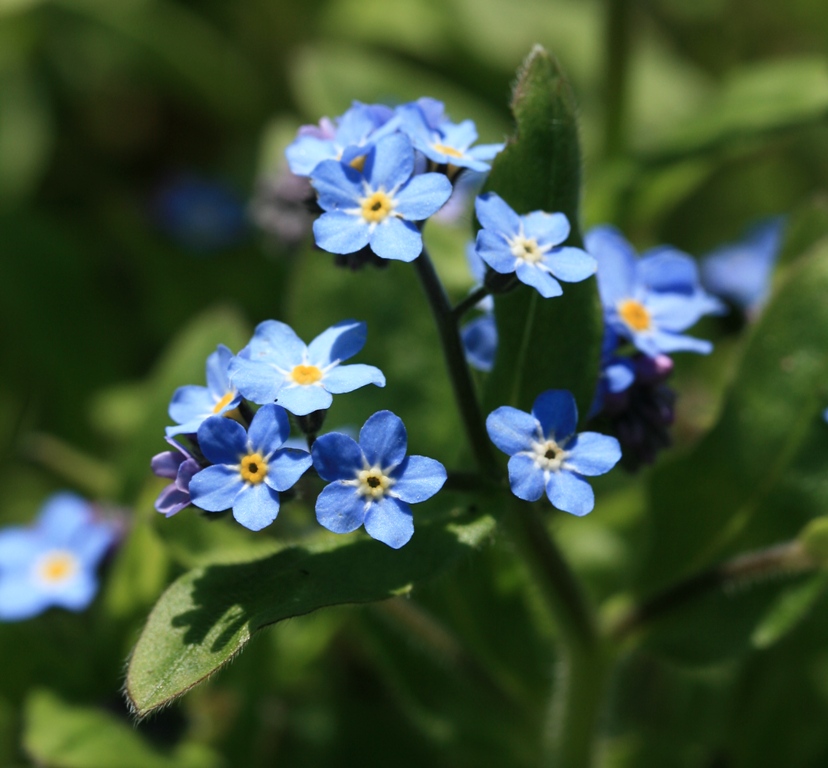
M. sylvatica or The Wood Forget-me-not
An erect biennial or perennial herb growing as a native, at least in England, on damp, fertile soils in woodland and rocky grassland. It is much more widespread in a wider range of habitats as a garden escape.
Widely cultivated throughout the temperate world, it is particularly associated with spring bedding schemes involving other spring-flowering subjects, notably daffodils, tulips, wallflowers, and primulas. Typically seeds are sown one year to flower the next. Though short-lived, plants readily self-seed in favourable situations. Plants maintain leaf growth throughout winter.
M. sylvatica is also a parent of numerous cultivars in shades of pink, blue and white. The cultivars ‘Bluesylva’ and the compact ‘Blue Ball’ have gained the Royal Horticultural Society’s Award of Garden Merit.
It was all over our old garden and looked very pretty with the combination of yellow dandelion flowers in spring!
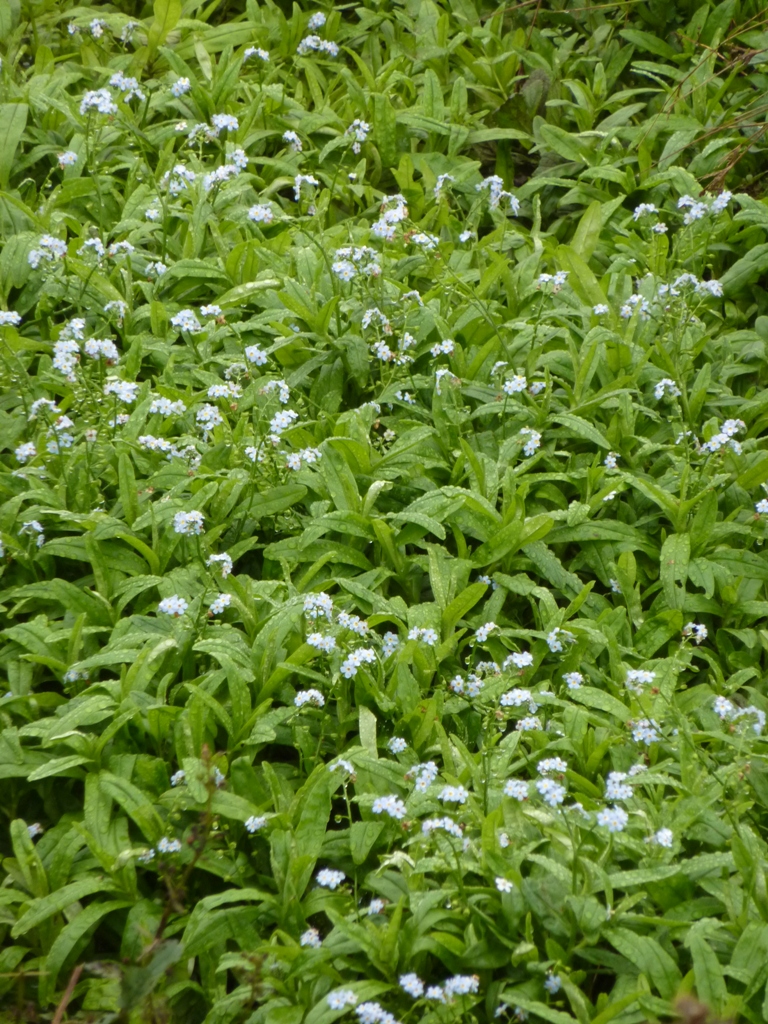
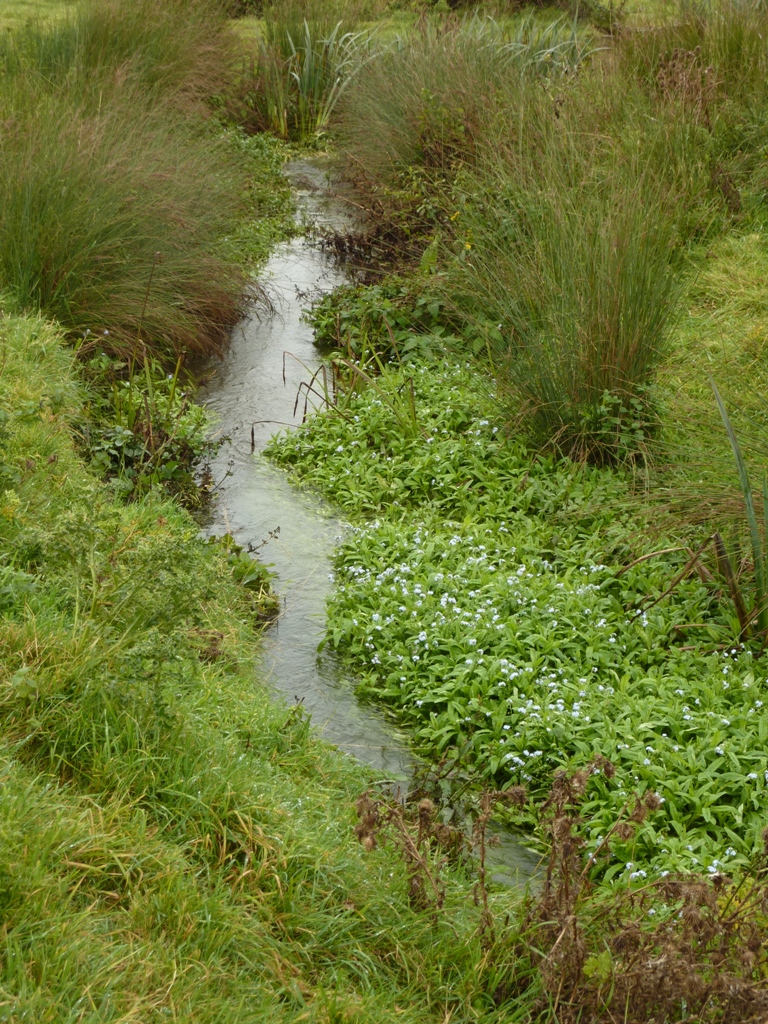
M. scorpioides or The Water-Forget-me-not
A stoloniferous or rhizomatous perennial herb of damp or wet habitats, usually in fertile, calcareous to mildly acidic soils. It is usually terrestrial, occurring by lakes, ponds, rivers and streams, in marshes and in fens, but may sometimes be aquatic, forming submerged patches or floating rafts.
It has large flowers and is therefore useful as an ornamental bog plant or for large ponds.
In France, this plant is recommended for tired, sore eyes and, taken internally, for fatigue and poor spirits. (Med. Flora)
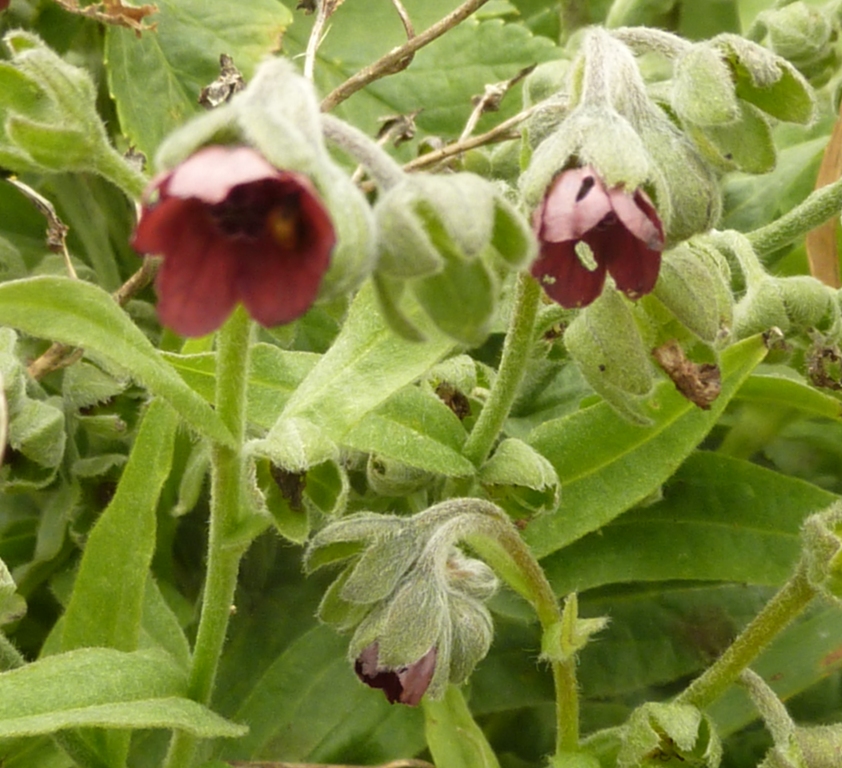
Cynoglossum officinale or Houndstongue
A biennial herb of disturbed ground, growing mostly on dry, often base-rich soils. Its habitats include coastal sand dunes and shingle, open grassland, woodland margins and clearings, field edges, cleared land and gravelly waste. It is unpalatable to grazing animals and is often frequent on disturbed ground by rabbit warrens and badger setts.
- The name Houndstongue (and the latin genus Cynoglossum) comes from the roughness of the leaf. Other common names are: houndstooth, dog’s tongue, gypsy flower and rats and mice (due to its smell).
- Houndstongue may be pollinated by bees, and may also self-pollinate.
- Herbalists nowadays, use the plant for piles, lung diseases, persistent coughs, baldness, sores, and ulcers but the effectiveness of all these uses is not supported by any scientific evidence.
- It contains tumorigenic pyrrolizidine alkaloids. It is toxic to cows and is specially dangerous to pasture owners. Not that it is often seen, as far as I know nowadays growing in pastures.
In 1725, houndstooth was presented in the family dictionary, Dictionaire oeconomique, as part of a cure for madness. In that book, madness was viewed as “a distemper, not only of the understanding, but also of the reason and memory, proceeding from a cold, which drys up everything it meets with that is humid in the brain.”
By the end of the 1830s, doctors in England were using houndstooth as an antiaphrodisiac to combat venereal excesses.
But also from J. Barker’s Med. Flora for presentday cures:
- The root (gathered in the autumn of its second year) and to a lesser extent the fresh leaves have been used since ancient times as an emolient for cracked, chapped skin.
- Internally it is a demulcent and sedative for coughs and is taken for haemorrhoids as well is applied to them. Besides the mucilage, gum, resin and essential oil, it contains two alkaloids cynoglossine and consolidine which are thought to contribute to the sedative effect.
Cynoglossum germanicum or Green Hound’s-tongue
A biennial or short-lived perennial herb occurring in glades or the margins of deciduous lowland woodland, usually Fagus sylvatica, Quercus spp. or Fraxinus excelsior; occasionally in hedgebanks.
The IUCN has assessed the global conservation status of this species as critically endangered.
It was declining markedly in Britain before the Second World War, for unknown reasons, but benefited greatly from the Great Storm of 1987, which felled many trees and opened up Britain’s woodlands.
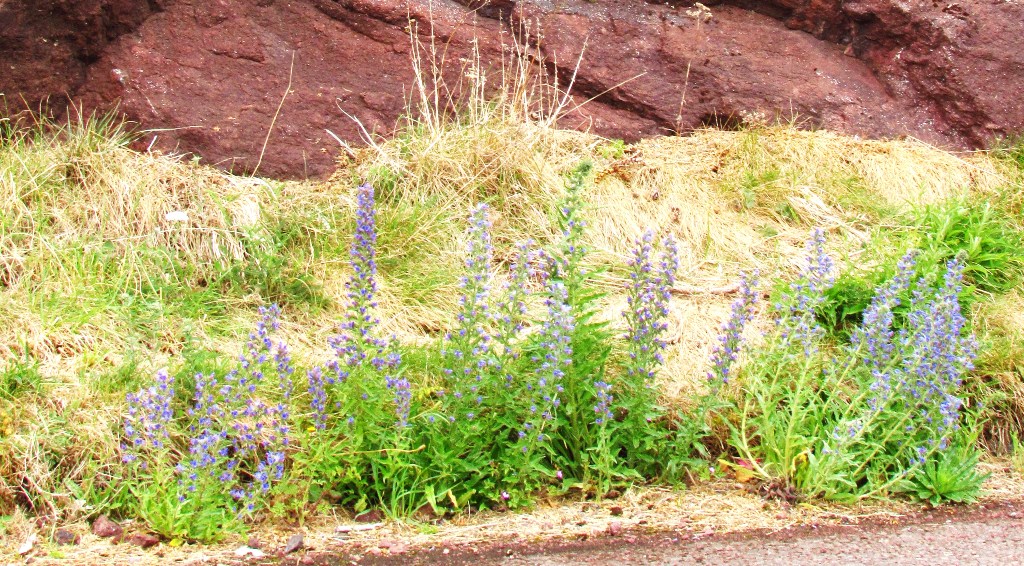
Echium vulgare or Viper’s-bugloss
A biennial herb of grassy and disturbed habitats on well-drained soils. It is found in bare places on chalk and limestone downs, on heaths, in quarries and chalk-pits, in cultivated and waste land, along railways, tracks and roadsides, and by the coast on cliffs, sand dunes and shingle.
This is a beautiful wildflower and is sometimes cultivated as an ornamental plant or used in wildflower mixes. The cultivar ‘Blue Bedder’ has gained the Royal Horticultural Society’s Award of Garden Merit.
I read in the RHS magazine that it is one of the most visited flower by bees. Information was collected via a mobile phone app by the RHS and had found that gardeners and allotment holders could make their plots more inviting to pollinators by planting Viper’s Bugloss (Echium vulgare, Teasel (Dipsacus fullonum) and Toadflax (Linaria vulgaris), as these had the most bee-visits.
Some interesting facts on the website you can find here at ‘the Poison Garden’
Dioscorides recommended it for snake bite. William Coles, the proponent of the Doctrine of Signatures claimed the nutlets look like a viper’s head and the speckled stalk looks like snakeskin.
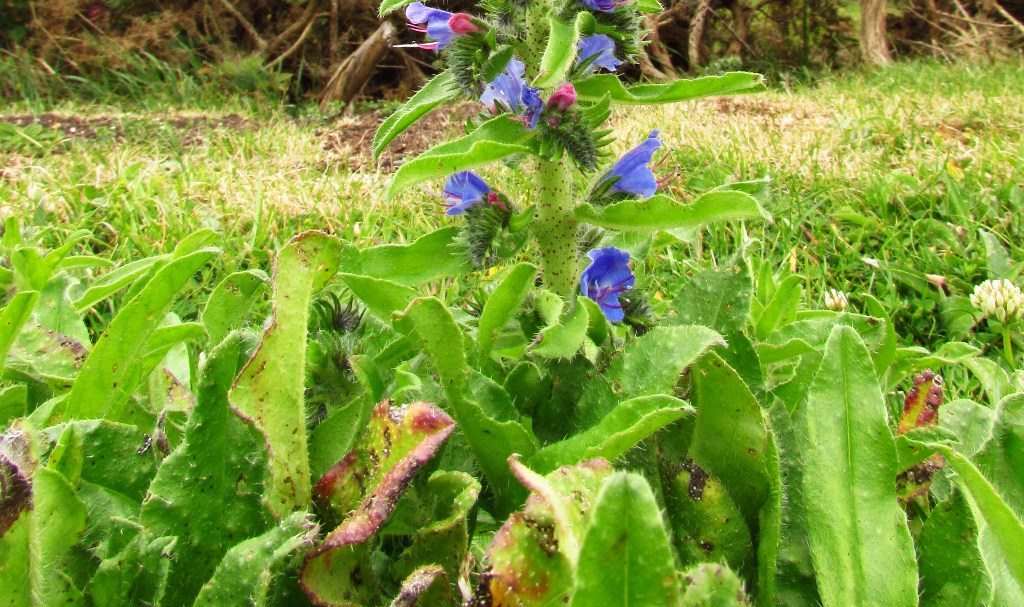
Bugloss, means ox tongue, apparently because of the roughness of the leaves.
Echium vulgare is, sometimes, said to be the plant known in Australia as Patterson’s Curse but this is Echium plantagineum . It is called Patterson’s curse because, it is said, a Mrs Patterson brought it to Australia to decorate her garden not knowing that it would thrive and escape and become a serious problem for livestock!
E. plantagineum or Purple Viper’s Bugloss was only native in South western British Isles in Cornwall and the Scilly Isles but at present has 514 records.
An annual or biennial herb, found in arable fields, on cliffs and in open sandy habitats by the coast. It has a long-lived seed bank, and populations vary greatly in size from year to year. It also occurs casually as a garden escape or outcast and it is occasionally found in areas that have been sown with seed mixtures to attract pollinators.
An archaeophyte in Britain and the Channel Islands and a neophyte in Ireland.
Like all plants containing pyrrolizidine alkaloids, consumption over a period can lead to liver failure, but no ill effects are seen initially.
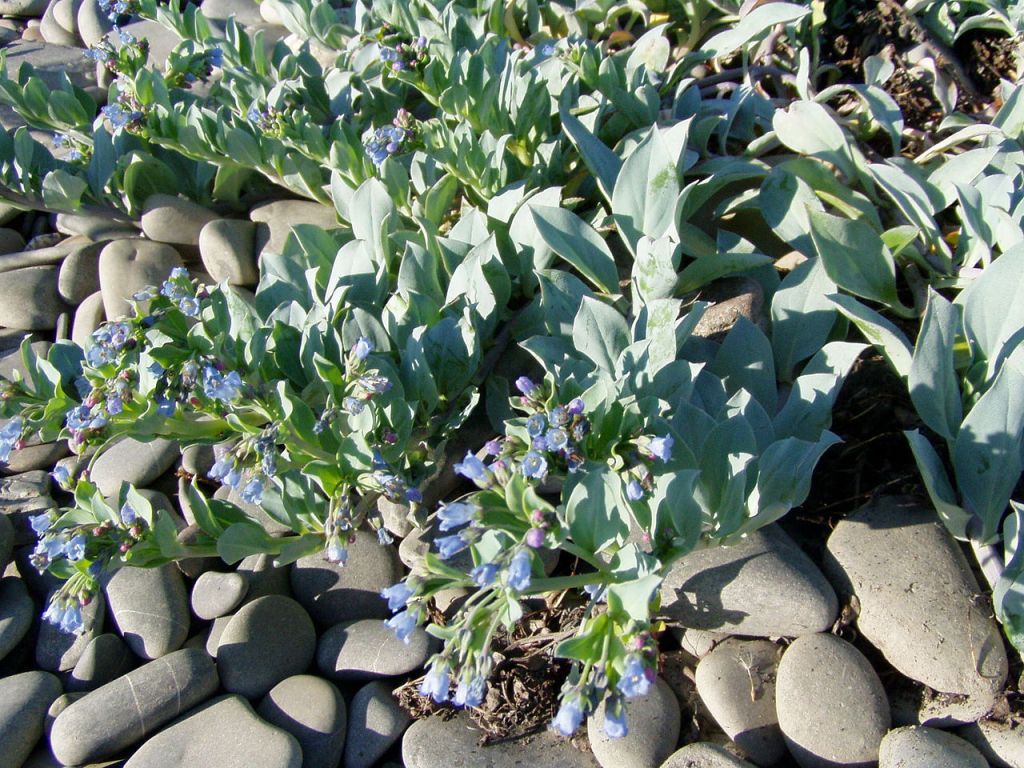
Mertensia maritima or Oysterplant
A perennial herb of gravelly beaches and shingle, occasionally on sand. It can also colonize earth and rocks tipped at the coast (Randall, 1988). Seeds can survive prolonged immersion in sea water, and dispersal by sea currents enables colonization of new, but sometimes transient, sites.
Leaves can be eaten raw or cooked. They are said to taste of oysters. No-one has yet noticed a resemblance to oysters though as not many of the tasters have ever eaten oysters! The flavour is fairly bland, the leaf is thick and has a very mucilaginous texture – it is probably this texture that reminds people of oysters. Eaten by the Inuit of Alaska. Flowers can be eaten raw.
But if people would like to eat this plant it is best from cultivated stock as the plant is not common!
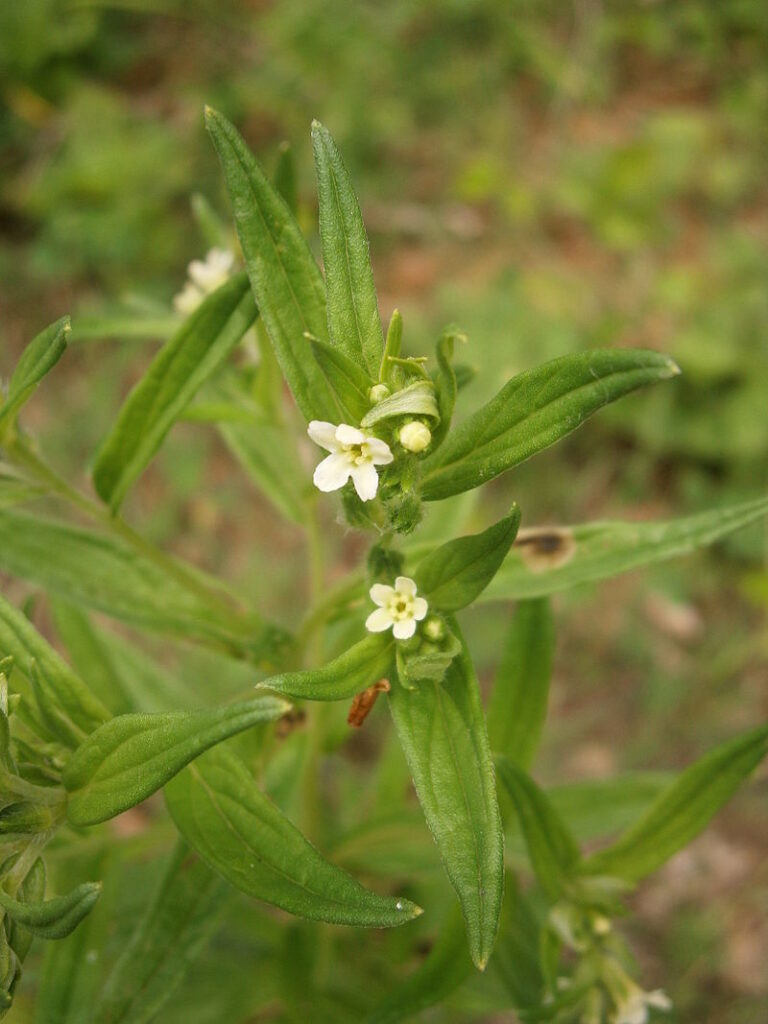
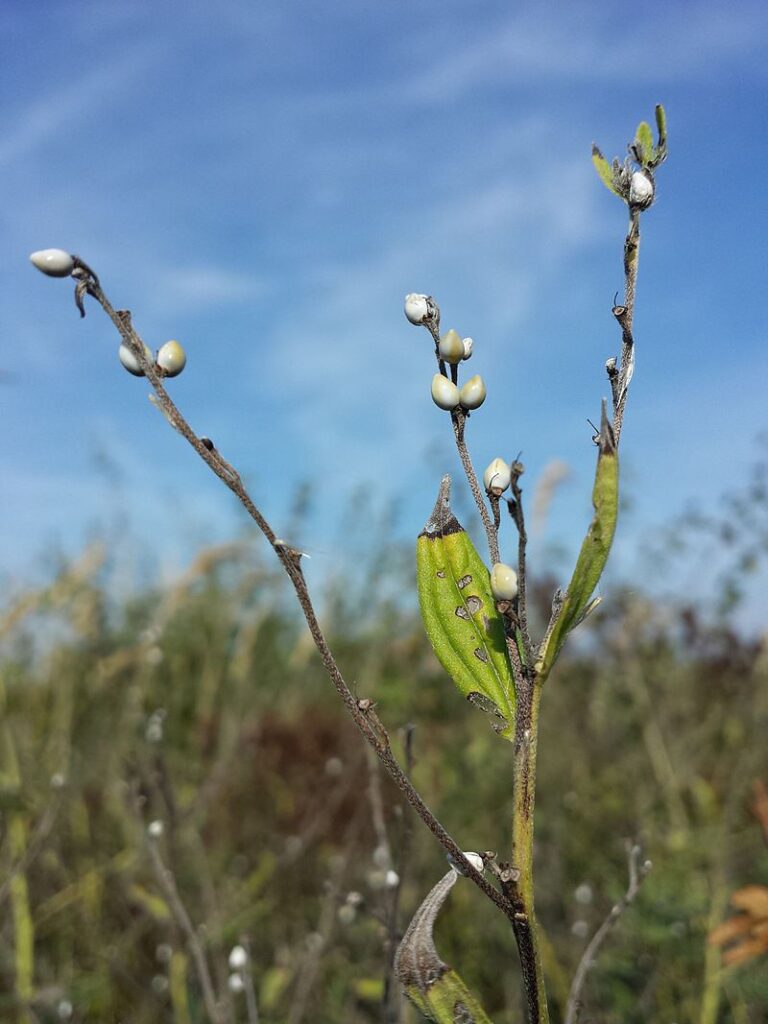
Lithospermum officinale or Common Gromwell
Lithospermum officinale or Common Gromwell
A shortly rhizomatous perennial herb of undisturbed places in grassland, hedgerows and wood margins, mostly on base-rich soils.
All parts of the plant have been traditionally used in Europe and Asia where the plant can be found as a natural medicinal remedy for various ailments.
L. officinale also appears to have held important cosmetic and ornamental value. For example, the roots were once used for colouring fibres and to produce makeup dye. Elsewhere, the well-preserved, intact fruits were found glued onto two wooden tubs found in the Yanghai Tombs of Xinjiang, China, from about 2,500 years ago. These nutlets probably had decorative worth. Their lustrous, porcelain-like appearance as well as their hardness also made them suitable and popular for use as beads in Bulgaria and central Europe as far back as the Neolithic period
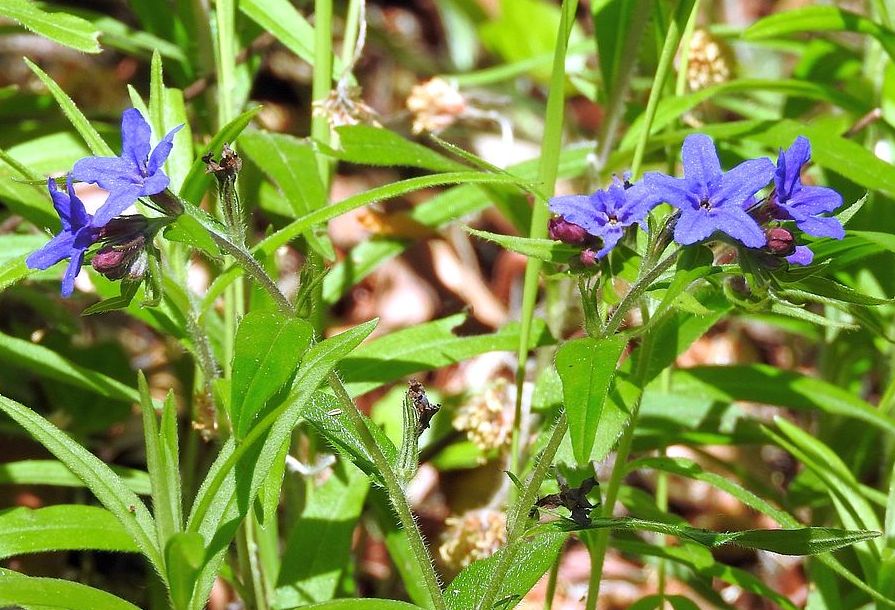
A perennial herb with creeping woody stems occurring in chalk and limestone districts in two distinct habitats. Inland, it grows in woodland edges and rides, and on lanesides and banks in partial shade. On the coast it is found amongst naturally dwarfed, open scrub on slumped cliffs, slopes and crags. It spreads by seed and from the stems rooting at nodes. It also occurs as a garden escape on roadsides and waste ground.
Field and Purple Gromwell (Lithospermum spp.) are not too common and Aegonychon purpurocaeruleum formerly known as Lithospermum purpureocaeruleum) or Purple Gromwell is probably the most attractive one. The blossoms are purple-reddish, then the colour of the flowers turns into a deep blue. The fruits are bright white capsules, with a glossy surface. They are very hard (hence the genus synonym Lithospermum, meaning “stone seed” for the hardness of these capsules).
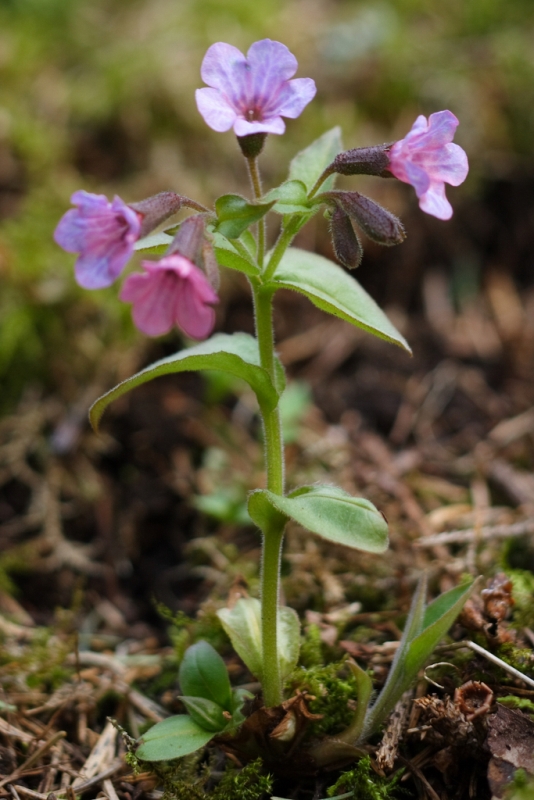
Pulmonaria spp. or Lungworts
The Lungworts (Pulmonaria spp.) are introduced although
- P. obscura or Suffolk Lungwort is native in old woods there.
A perennial herb of poorly drained chalky boulder clay, occurring in three ancient woodlands dominated by Acer campestre, Corylus avellana and Fraxinus excelsior and with a long history of coppice management, especially by rides and clearings. It will tolerate deep shade but flowers best in more open areas.
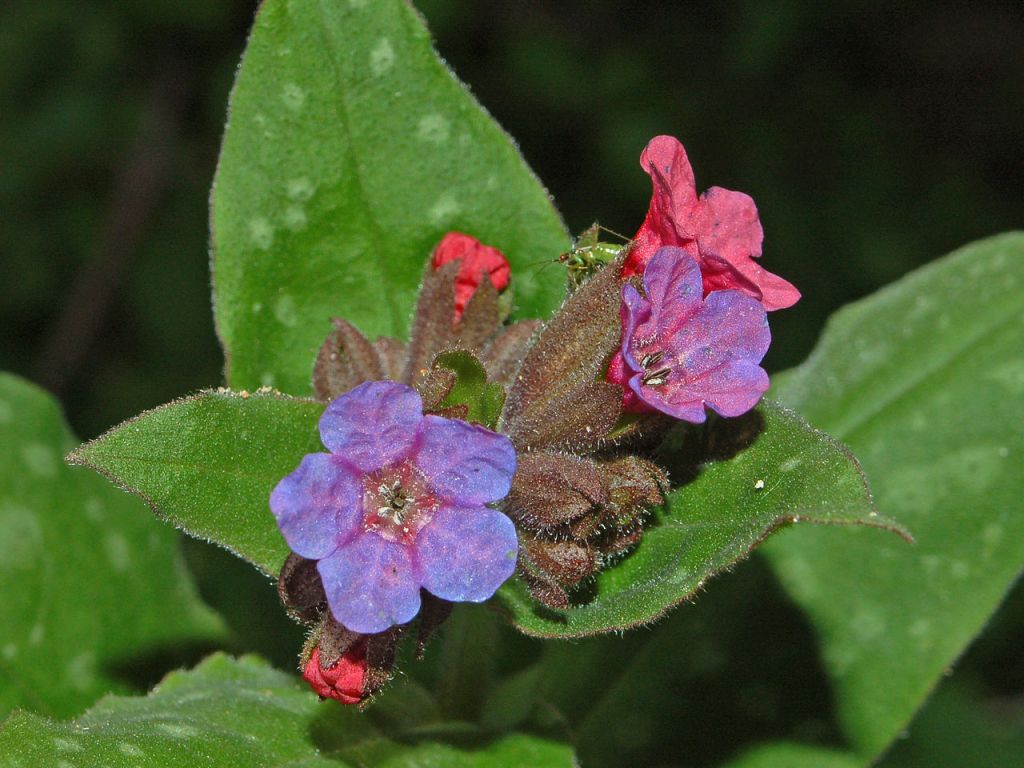
Pulmonaria officinalis or Lungwort (Neophyte)
A perennial herb, naturalized in woodlands and scrub, on banks and rough ground, and also occurring on refuse tips and waste ground.
The scientific name Pulmonaria is derived from Latin pulmo (lung). In the times of sympathetic magic, the spotted oval leaves of P. officinalis were thought to symbolize diseased, ulcerated lungs, and so were used to treat pulmonary infections. The common name in many languages also refers to lungs, as in English “lungwort”, German Lungenkraut, Dutch Longkruid, French herbe aux poumons andSerbian plućnjak…
- Pulmonaria species are used as food plants by the larvae of some Lepidoptera species. These include the case-bearer Coleophora pulmonariella which feeds exclusively on P. saccharata and the moth Ethmia pusiella which has been recorded on P. officinalis.
Pulmonaria are used as ornamental garden plants, particularly P. saccharata, P. angustifolia and P. longifolia. They are especially valued as groundcover (and also see here, a fabulous article on 24 groundcovers for your garden) in damp shaded areas, producing their blue and/or pink flowers in late winter and early spring, accompanied by dense clusters of heart-shaped leaves that are often strikingly mottled and marbled, throughout summer.
The following cultivars, of mixed or uncertain parentage, have gained the Royal Horticultural Society’s Award of Garden Merit:
- ’Blue Ensign’
- ’Diana Clare’
- ’Lewis Palmer’
- ’Sissinghurst White’
- ’Vera May’
The next member of the Boraginaceae Family is the Genus Symphytum or Comfrey. As there is too much to say about this plant I will leave this till next week! Hope to see you then.
